RAF Mount Batten on:
[Wikipedia]
[Google]
[Amazon]
RAF Mount Batten was a
 With the formation in April 1918 of the
With the formation in April 1918 of the
 On 1 October 1928, following re-building, the old Cattewater seaplane station was opened as RAF Mount Batten to provide a base for flying boats to defend south-west England. The first squadron ( No. 203 Squadron RAF) was equipped with the
On 1 October 1928, following re-building, the old Cattewater seaplane station was opened as RAF Mount Batten to provide a base for flying boats to defend south-west England. The first squadron ( No. 203 Squadron RAF) was equipped with the
Royal Air Force
The Royal Air Force (RAF) is the United Kingdom's air and space force. It was formed towards the end of the First World War on 1 April 1918, becoming the first independent air force in the world, by regrouping the Royal Flying Corps (RFC) and ...
station and flying boat base at Mount Batten
Mount Batten is a 24-metre (80-ft) tall outcrop of rock on a 600-metre (2000-ft) peninsula in Plymouth Sound, Devon, England, named after Sir William Batten (c.1600-1667), MP and Surveyor of the Navy; it was previously known as How Stert.
Af ...
, a peninsula in Plymouth Sound
Plymouth Sound, or locally just The Sound, is a deep inlet or sound in the English Channel near Plymouth in England.
Description
Its southwest and southeast corners are Penlee Point in Cornwall and Wembury Point in Devon, a distance of abo ...
, Devon
Devon ( , historically known as Devonshire , ) is a ceremonial and non-metropolitan county in South West England. The most populous settlement in Devon is the city of Plymouth, followed by Devon's county town, the city of Exeter. Devon is ...
, England
England is a country that is part of the United Kingdom. It shares land borders with Wales to its west and Scotland to its north. The Irish Sea lies northwest and the Celtic Sea to the southwest. It is separated from continental Europe b ...
. Originally a seaplane station opened in 1917 as a Royal Navy Air Service Station Cattewater it became RAF Cattewater in 1918 and in 1928 was renamed RAF Mount Batten. The base is named after Captain Batten, a Civil War
A civil war or intrastate war is a war between organized groups within the same state (or country).
The aim of one side may be to take control of the country or a region, to achieve independence for a region, or to change government policies ...
commander who defended this area at the time, with the Mountbatten family
The Mountbatten family is a British dynasty that originated as an English branch of the German princely Battenberg family. The name was adopted on 14 July 1917, three days before the British royal family changed its name to “Windsor”, by ...
motto ''In Honour Bound'' taken as the station's motto.
Today, little evidence of the RAF base remains apart from several memorials, some aviation-related road names, the main slipway and two impressive Grade II listed F-type aeroplane hangars dating from 1917.
History
Royal Naval Air Station Cattewater
As early as 1913 the shelteredCattewater
The city of Plymouth, Devon, England is bounded by Dartmoor to the north, the Hamoaze to the west, the open expanse of water called Plymouth Sound to the south and the river Plym to the east.
The Cattewater is that stretch of water where the mo ...
in Plymouth Sound
Plymouth Sound, or locally just The Sound, is a deep inlet or sound in the English Channel near Plymouth in England.
Description
Its southwest and southeast corners are Penlee Point in Cornwall and Wembury Point in Devon, a distance of abo ...
was used for seaplane trials and in 1916 plans to open a Royal Navy seaplane station were agreed. In February 1917 RNAS Cattewater was opened. It had a hangar for aircraft, storage and maintenance and a stone pier with a railway track that enabled a steam crane to place the seaplanes in and out of the water. The first aircraft based there were the Short 184
The Short Admiralty Type 184, often called the Short 225 after the power rating of the engine first fitted, was a British two-seat reconnaissance, bombing and torpedo carrying folding-wing seaplane designed by Horace Short of Short Brothers. It ...
and these were soon followed by other seaplanes. Operational flying was carried out from Cattewater, mainly coastal patrols.
Royal Air Force Station Cattewater
 With the formation in April 1918 of the
With the formation in April 1918 of the Royal Air Force
The Royal Air Force (RAF) is the United Kingdom's air and space force. It was formed towards the end of the First World War on 1 April 1918, becoming the first independent air force in the world, by regrouping the Royal Flying Corps (RFC) and ...
the station became RAF Cattewater. The station was little used but in 1919 the station became notable with the arrival of the Curtiss NC 4 flying boat making the first aerial crossing of the Atlantic. From 1923 the station was re-built and extended and was re-opened in 1928.
Royal Air Force Station Mount Batten
Supermarine Southampton
The Supermarine Southampton was a flying boat of the interwar period designed and produced by the British aircraft manufacturer Supermarine. It was one of the most successful flying boats of the era.
The Southampton was derived from the experime ...
. The station also became a base for high-speed air sea rescue launches on which, in the 1930s, was employed Aircraftman Shaw, better known as T. E. Lawrence
Thomas Edward Lawrence (16 August 1888 – 19 May 1935) was a British archaeologist, army officer, diplomat, and writer who became renowned for his role in the Arab Revolt (1916–1918) and the Sinai and Palestine Campaign (1915–1918 ...
.Michael Korda
Michael Korda (born 8 October 1933) is an English-born writer and novelist who was editor-in-chief of Simon & Schuster in New York City.
Early years
Born in London, Michael Korda is the son of English actress Gertrude Musgrove and the Hungarian ...
, ''Hero: The Life and Legend of Lawrence of Arabia'' , p. 642
With the start of the Second World War there was an increase in operational flying from Mount Batten. It was also the target for a number of German air raids resulting in the destruction of one of the hangars and a Short Sunderland
The Short S.25 Sunderland is a British flying boat patrol bomber, developed and constructed by Short Brothers for the Royal Air Force (RAF). The aircraft took its service name from the town (latterly, city) and port of Sunderland in North East ...
on 28 November 1940. At the end of the war the station became a Maintenance Unit.
At the end of the 1950s the station became the Marine Craft Training School and from 1961 became the main base of the RAF Marine Branch
The Marine Branch (1918-1986) was a branch of the Royal Air Force (RAF) which operated watercraft in support of RAF operations. Just days after the creation of the RAF itself, the Marine Craft Section (MCS) was created with the transfer of Roya ...
, with the closure of No. 238 MU, Calshot until the marine branch closed in 1986 and the School of Survival until it moved to RAF St Mawgan
Royal Air Force St Mawgan or more simply RAF St Mawgan is a Royal Air Force station near St Mawgan and Newquay in Cornwall, England. In 2008 the runway part of the site was handed over to Newquay Airport. The remainder of the station continues t ...
in 1992. It also housed No. 3 Maritime Headquarters Unit of the Royal Auxiliary Air Force
The Royal Auxiliary Air Force (RAuxAF), formerly the Auxiliary Air Force (AAF), together with the Air Force Reserve, is a component of His Majesty's Reserve Air Forces (Reserve Forces Act 1996, Part 1, Para 1,(2),(c)). It provides a primary rein ...
providing Communications and Operations Room personnel.
RAF units and aircraft
References
Citations
Bibliography
* *External links
{{DEFAULTSORT:Mount Batten Royal Air Force stations in Devon Seaplane bases in the United Kingdom Seaplane bases in England Royal Air Force stations of World War II in the United Kingdom